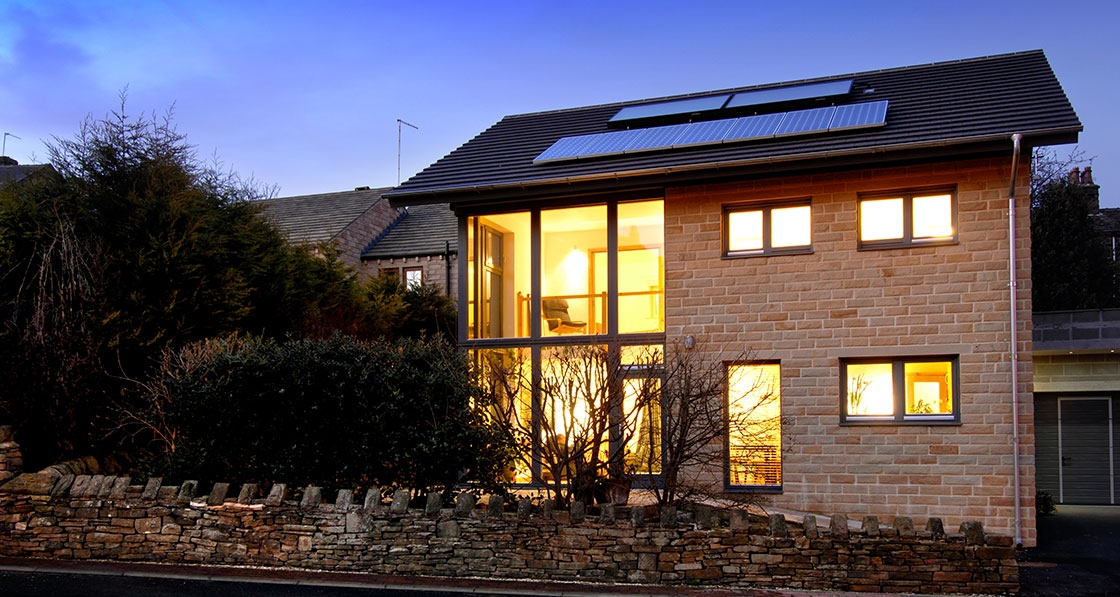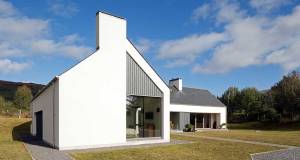
- Government
- Posted
Exclusive: UK may deliver EU sustainable building targets in spite of Brexit – while Scotland & Wales commit
The Scottish and Welsh governments have pledged to implement a landmark EU policy that requires all new buildings to be nearly zero energy buildings (nZEBs), while England and Northern Ireland may follow suit, an investigation by Passive House Plus has revealed.
This article is featured in issue 20 of Passive House Plus magazine, which also includes analysis on this story, and case studies including homes which meet the Irish nZEB standard, and similar UK projects. To read the new issue - including immediate digital access - click here to subscribe for as little as €10, or click here to fill out our enquiry form and request a free copy
Meanwhile, the UK is unprepared to meet a requirement that all new public buildings completed after 31 December 2018 are nZEBs, and the London Mayor’s office is considering introducing energy demand reduction targets such as the passive house standard into its zero carbon plans for the city. The exclusive report is published in the new issue of Passive House Plus, which also includes analysis on this unfolding story, useful comparative information on Ireland's nZEB implementation, including case studies on Irish nZEBs.
The recast EU Directive on the energy performance of buildings requires member states to make all new public buildings nZEBs by the end of 2018, with all new buildings following by the end of 2020, while also setting nZEB targets for refurbishments. The Welsh and Scottish governments have issued statements to passive House Plus including the verbatim response that they had “transposed all requirements of Directive 2010/31/EU to date and our intention is to continue to do so.” The Welsh government said a forthcoming review of energy standards “is intended to deliver nearly zero energy requirements in line with the directive.” The Scottish government cited a review of energy standards commencing in spring 2017, which will consider the 2013 Sullivan Report recommendations that the proposed 60 and 75% reductions in carbon emissions “would also deliver new buildings which meet the definition of ‘nearly zero energy’ new buildings in the EU Directive.”
Meanwhile, a spokesperson for the Department for Exiting the EU has told Passive House Plus that the government will continue to implement current and forthcoming requirements of EU law up until the point that Britain leaves the EU. From then on the Great Repeal Bill, once enacted, will be used to “lift and shift” EU legislation into British law.
A Department for Communities and Local Government spokesperson said that the government implemented “the European requirement for ‘Nearly Zero Energy Buildings’ in changes to the Building Regulations in December 2012”, but added that nZEBs “should be cost optimal and Member States are required to report against this. The UK’s report to the European Commission in 2013 showed that standards are cost optimal. Our Housing White Paper sets out that we are undertaking a review of energy performance standards as required under the Housing and Planning Act 2016 – this will include a further review of cost optimality.”
While this response may suggest that by adopting cost optimal standards, a member state already satisfies the nZEB target, the notion doesn’t stand up to scrutiny. As the commission explained in guidelines on nZEBs issued to member states in July 2016, nZEBs may become cost optimal by 2020, as the standard becomes mainstream. “By then, technology costs are likely to be lower in reaction to more mature markets and larger volumes. It is therefore likely that the nZEB levels will correspond to the cost-optimum for 2020,” the commissioned stated.
Member states were obliged to transpose Article 9 of the recast directive – which contains the nZEB requirements – by early 2013 and report on progress. The UK submitted a collective response for the four home nations, titled ‘Increasing the number of nearly zero energy buildings’. The report stated: “The intent to deliver ’zero carbon’ new buildings is one of the major steps that UK is taking towards meeting both its carbon targets and energy targets.” It cited England’s plans to introduce the zero carbon standard for new homes in 2016, a benchmark that included energy demand reduction, on-site renewables and, controversially, ‘allowable’ solutions — a carbon offsetting proposal. With similar plans in Scotland, Wales and Northern Ireland, the report proposed that zero carbon would “provide a suitable platform for both the definition and delivery of nearly zero energy new buildings” and renovations in line with EU requirements.
However, in 2015 then chancellor of the exchequer George Osborne announced that: “The government does not intend to proceed with the zero carbon Allowable Solutions carbon offsetting scheme, or the proposed 2016 increase in on-site energy efficiency standards, but will keep energy efficiency standards under review, recognising that existing measures to increase energy efficiency of new buildings should be allowed time to become established.”
It has been widely reported that the UK is unlikely to implement the nZEB targets as it departs the EU, with UK Green Building Council (UK-GBC) policy advisor Richard Twinn telling Building magazine it was “unlikely” the target would be kept. “The government may well not decide to have nZEBs as nothing exists in UK legislation saying it has to meet that target,” he said. The UK-GBC has also reported that the government has scrapped the zero carbon policy for non-domestic buildings.
However a European Commission spokesperson told Passive House Plus that “we understand that the UK has withdrawn the zero carbon Allowable Solutions carbon offsetting scheme, but not the targets as such. “In the time available, we have obviously not been able to confirm this with the UK authorities and without further investigation we cannot conclude nor prejudge that there has been a breach of the Directive.”
Responding to the news, AECB CEO Andy Simmonds said: “The Scottish and Welsh governments are representing citizens’ interests with great integrity. They demonstrate basic economic common sense: their design and construction sectors will benefit from staying close to a modern and international construction industry - rather than a parochial one. Improved quality and climate-change preparedness of new buildings will reduce greenhouse gas and other harmful emissions and improve health and wellbeing for building occupants and the wider community. England would benefit from doing the same.”
Since October last year, the Mayor of London has imposed a zero carbon planning requirement in the London area – targets which were retained after the government’s zero carbon U-turn in order to help ensure the development industry in London is prepared for the introduction of ‘nearly zero energy buildings’ by 2020. The targets, which apply to all new buildings, currently include a 35% reduction in regulated carbon emissions on site compared to building regulations, with the remainder being accounted for via carbon offsetting. A spokesperson for the mayor said: “The Mayor is committed to lead by example in reducing carbon emissions across the Greater London Authority, as part of wider efforts to move towards London becoming a net zero carbon city by 2050. City Hall experts have assessed ‘nearly zero energy building’ requirements and believe that the Mayor’s current policies meet or even exceed their carbon reduction targets. “City Hall encourages energy demand reduction, as set out in the London Plan. We are aware of the Passivhaus requirement to meet an energy demand target. While we do not currently set targets for reducing energy demand, we will consider developing one in the future.”
What are nZEBs?
The EU defines nZEBs as buildings with “a very high energy performance” as determined in accordance with the recast directive, which takes account of energy for heating, hot water, cooling, ventilation and lighting but not plug loads. The directive states that: “The nearly zero or very low amount of energy required should be covered to a very significant extent by energy from renewable sources, including energy from renewable sources produced on-site or nearby.”
Commission guidance from July 2016 on nZEBs advised member states to use benchmarks for four different climate zones. The examples given for the UK & Ireland’s (oceanic) climate zone are as follows:
Single family houseNet primary energy: 15-30 kWh/m2/yr
Total primary energy: 50-65 kWh/m2/yr
On-site renewables: 35 kWh/m2/yr
Office
Net primary energy: 40-55 kWh/m2/yr
Total primary energy 85-100 kWh/m2/yr
On-site renewables: 45 kWh/m2/yr







